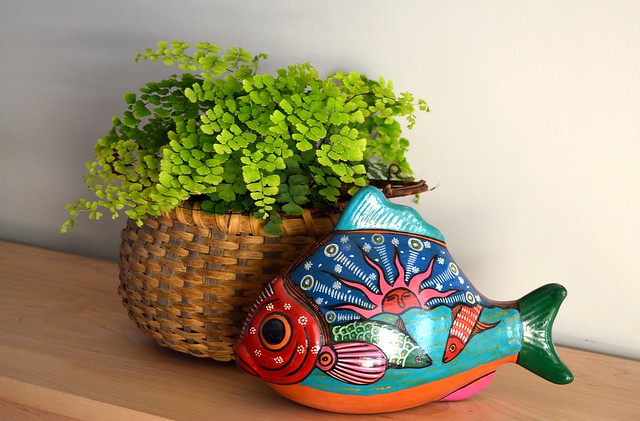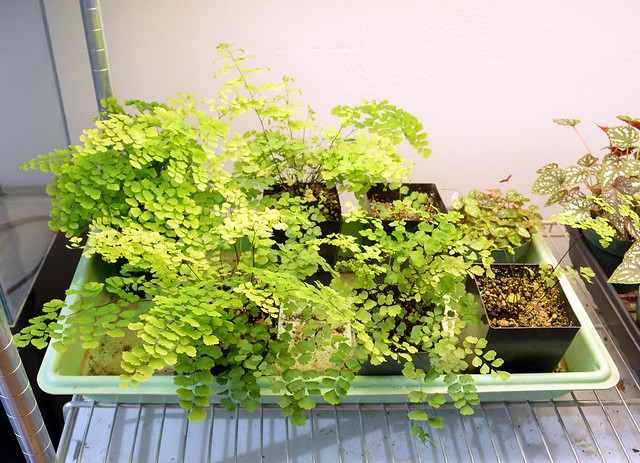
Anybody can stage a photo, but can anybody grow a plant?
I recently had a brief online discussion with my friend Marianne, who blogs at Small Town Gardener. Marianne took issue with a magazine article describing maidenhair ferns (Adiantum) as an "easy" houseplant to brighten the home. The picture of a pretty little fern (not the photo above) was captioned, "Living things boost energy in a space. Maidenhair and Boston ferns (shown) get high marks for their hardiness (read: they're hard to kill) and bring lushness to a bookshelf, console, or entry table. For something a tad daintier, try white allium."
What does "boost energy" even mean? Moreover, what could possibly be daintier than a maidenhair fern, and what the heck is "white allium"? But Marianne's takeaway was, "Maidenhair and Boston ferns easy to grow indoors? What?!?!? This type of cutesy misinformation makes me absolutely crazy. Why? Because when people new to plants try and fail to grow these high-humidity moisture lovers well (and I do stress 'well'), they then think of themselves as failures."
I've grown several different kinds of maidenhair fern indoors and I have found them to be quite easy. Heck, a couple of them are even greenhouse weeds. I grabbed the plant for the photo at the top from this group on my light stand, where they're growing in the middle of winter without any supplemental humidity:

It's true that they love high humidity and will shrivel to a crisp if you move them from high to low humidity—for example from a greenhouse to your living room—but once acclimated they do quite well. The trick is to keep them neither too wet nor too dry, and I suspect that's where most beginners fail. But meet their fairly minimal needs, and they will grow and grow.
I pointed this out and Marianne's reply was "I agree, but you're a plant breeder John—far from a novice—and this is directed specifically at novice-hey-I-want-something-cool gardeners. I do love Adiantum and I know what needs to happen—but I can be a poor mother to my indoor plants and I'd have a hard time persuading it to keep its clothes on. Beginners would just wonder why they failed."
My comeback: beginners always fail. We become good gardeners because we fail. But we don't give up, and we learn from our mistakes. That's a message I wish novice gardeners would hear more often: it's okay to kill a plant! We're not talking about puppies and kittens here. I sometimes hear people refer to their plants as their pets, or even "babies". Get that idea out of your head right now. My plants are not my babies, and they're not my pets. I don't talk to my plants, except to curse at them occasionally (and that's entirely involuntary). I don't subscribe to that 1970's mumbo jumbo about plants somehow sensing our thoughts or feeling pain.
I've been growing plants for nearly 50 years but like every good gardener, I was a beginner myself once upon a time. I may have a lot of experience, but that experience has been at the expense of many a plant, and I still kill plants now and then. This is the dirty little secret of every good grower: we have all killed more plants than you can possibly name. But we didn't give up and we didn't quit; we just moved on to the next plant. Yes, gardeners are serial killers.
It can take some time to kill a plant, which can make it difficult to figure out why it died. The fastest way to kill a plant is by over or under watering. A slower way is to give it insufficient light, and I think this is where many beginners fail without realizing why. My own major peeve is that magazines will frequently stage a photo with a big, lush, beautiful plant in a space well away from windows or natural light, usually an inside corner of a room, where it absolutely cannot grow. Plants may not be puppies or kittens, but they are still living things and have some basic needs. Most houseplants need more light than you think, and most of the indoor spots that you think get bright natural light are the equivalent of deep shade outdoors. Here are my own lessons, and these apply to the plants you grow outdoors as well as houseplants:
Don't be afraid to try something new. This is the only way you will learn. You can try growing the same plant a different way—different soil, different watering, different light exposure—or move on to a new kind of plant entirely.
Don't feel bad if it doesn't thrive. Not every plant will.
Don't be too quick to give up on a plant as dead. This is an important one because sometimes all a plant needs is to adjust to your conditions. Some plants will shrivel up, lose all their leaves, even die right down to the pot, but as long as there's something still alive in that pot, however small, it will come back. Give it a few weeks and see what happens, but eventually...
Don't be afraid to admit failure. At some point you need to just throw in the towel, and toss the plant in the trash (or compost). It may be dead, or it may be not-quite-dead. Either way, don't feel bad about it. You just made space for another plant, so go out and get one.
The biggest mistake a beginner can make? Giving up. Now go out, try something new, and don't be afraid to kill it! And be sure to visit Marianne's lovely blog, Small Town Gardener, and find her on Facebook.

Great post - will answer it properly, but a few thoughts now. I completely agree that it's okay to kill a plant (thank goodness or I'd feel pretty ashamed of myself), I just think we shouldn't set non or novice gardeners up to fail by calling some plants easy that rank more at an intermediate level. In this case, humidity is the missing key in that designation of 'easy,' and unless someone understands that instinctively or through experience, they'll be disappointed - depending on their level of commitment. I'd rather see them start with something truly easy - a pothos, a philodendron or a rubber plant, feel confident and move on to more complex techniques of hardening off plants that need a gradual humidity drop. Glad we agree about the white allium. Still laughing over that one.
ReplyDeleteAt least designers are trying to include plants, even if they don't always get placement right.
ReplyDeleteI hate letting go of warm weather and so bring potted annuals indoors every winter. It helps me battle winter depression. Some make it, some don't, many of the poor plants are history by February. This years Supertunia didn't last, but at least I got to enjoy the flowers for another month and a half. If anyone else wants to try, geraniums, snapdragons, dahlias, impatiens, nicatina, and gerbera daisies thrive in a sunny window. Do remember to water them though. One of the first lessens I learned is that they have to be previously potted before being brought in, otherwise they spend all winter regrowing their root systems instead of flowering. You still have beautiful leafy plants, but no color.
The 'boosts energy' in the article, in case that was a serious question, means our subconscious reacts to living things around us to 'boost' our mood. Just like sitting in sunlight makes you feel a little better.
About the 1970s mumbo jumbo, they recently did some of the experiments again and learned some amazing things. Try to find WHAT DO PLANTS TALK ABOUT? on the NOVA channel. It's worth seeing.